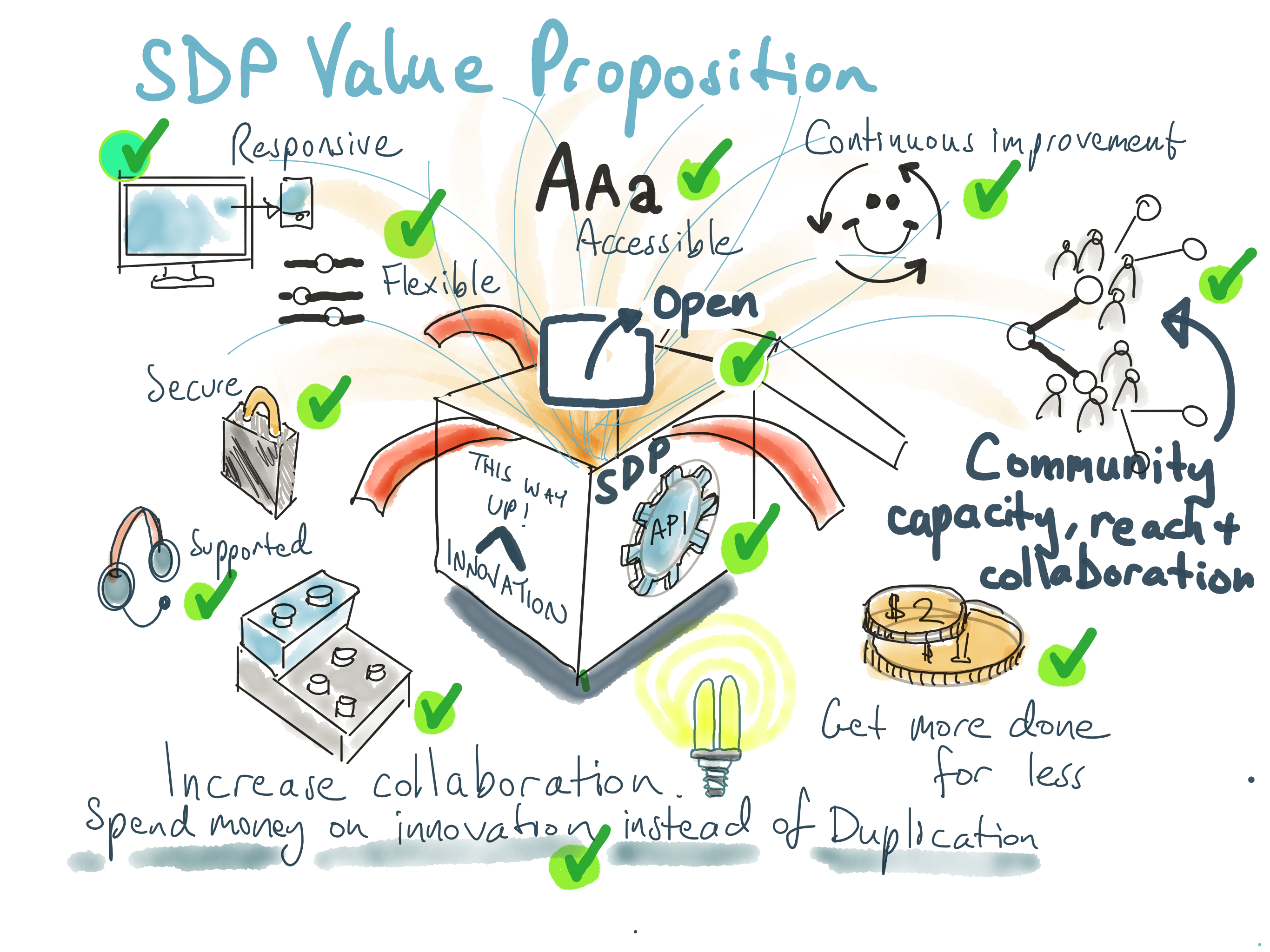
What is Single Digital Presence (SDP)?
SDP is the new open platform that helps to reduce the cost and effort required for Victorian government agencies to develop digital solutions. A Department of Premier and Cabinet (DPC) initiative, it consists of three products — Bay (an open-source platform based on Lagoon), Tide (a Drupal CMS distribution) and Ripple coupled with Nuxt (the frontend presentation layer).
The journey to one platform
In 2015, DPC was running 36 different websites, with different branding, different platforms and different content management system (CMSs). In addition, across Victoria there were over 900 vic.gov.au domains.
DPC wanted to simplify web delivery and provide a consistent and user-friendly citizen experience. Part of this vision is about delivering a unified platform that will deliver time and cost savings, which can then be redirected into more innovative solutions.
For more of this ‘backstory’ and info on some great user research DPC conducted, read Jithma Beneragama’s (DPC’s Director Digital Engagement) blog Digital transformation — starting with the .
The vision
DPC’s vision is to make it easier for citizens to find, understand and use Victorian Government information. It also wants to make it faster, easier, and cheaper for Victorian Government agencies to build new sites or migrate existing ones, by leveraging the SDP platform.
The value
Amber Benjafield, Senior Project and Engagement Manager at DPC (and the SDP project manager) said the SDP delivers value to three major groups — citizens, public sector content authors and the Victorian Government as a whole
Citizens: “DPC wanted to improve the citizen experience and we wanted to make government information easier to find, understand and act on,” said Amber. “This is the citizen-facing value.” .
Content authors: The goal here was to create a CMS that content authors love. “It also gives the Victorian public service the opportunity to upskill in their digital knowledge, which ultimately benefits their careers, too.”.
Government: “SDP provides value to the government in cost savings, by building a single platform that can be used widely but is supported centrally,” Amber said. “It’s about all the benefits that you get when you consolidate to a single platform, such as only fixing breakages and security risks once, only maintaining one platform, and building in new features that everyone can use but only paying for them once. Everyone will benefit once the foundations are laid because all of the future investment will be on continuous improvement...not just maintaining the current but improving. The end result is a technical platform that’s monitored for security vulnerabilities, regularly patched, and with frequent penetration testing.”
So if government agencies choose to leverage the SDP platform, they have time and money to spend on on innovation instead of maintenance.
Some of the specific benefits to citizens are:
Consolidation of DPC information into one platform with content designed around joined-up user journeys
A consistent user experience
Improved online experience so citizens can find, understand and act on answers to their questions
Responsive website templates that respond to different devices (desktop computers, tablets, smartphones)
Information architecture that reflects the citizen’s experience and understanding of government
Accessibility benefits, with websites complying with WCAG 2.0 accessibility standards (Level AA)
Some of the specific benefits to the Victorian Government are:
A platform that’s supported by continuous delivery and continuous improvement
Reduced time-to-market for new websites via standard templates and processes
A common, flexible platform
A technical platform that’s monitored for security vulnerabilities, regularly patched, and with frequent penetration testing
Consolidation of hosting to leverage cost savings
A platform that supports joined-up user journeys
Reduced barrier to entry through the single CMS
The benefits of open platform
DPC wanted to build an open platform for several reasons. Firstly, an open platform would mean there wasn’t one single entity benefiting from the platform in terms of license fees and other costs. Secondly, as Amber said, “...being open allows for wider contribution across the dev community, which opens it up to innovation.”
Originally we were going to build this new platform from scratch, but then we discovered that Lagoon had just been open-sourced. We investigated Lagoon further in partnership with DPC. DPC’s team was pretty excited about the open source platform — it meant they didn’t have to invest time and money into building something new.
In the end, the benefits clearly outweighed any uncertainty and so SDP’s open platform is now truly open, because it’s built using an open source platform, which makes the entire stack open source.
SDP — Bay, Tide and Ripple
Bay, Tide and Ripple were named by DPC, continuing with the water themes in Drupal and Kubernetes.
Bay is the platform itself, and forms the infrastructure layer on which SDP has been built. Salsa and our partner built Bay using open-source platform, . This cloud-based solution allows Victorian government agencies to build, test and deliver websites via the cloud. More about Bay.
Tide is the Drupal distribution that manages content. It’s a customised build of Drupal 8 and forms a central repository where all content can be managed. Importantly, Tide allows content sharing — one source of content that can then be ‘served’ to different sites. Amber believes the centralised content repository is the most exciting feature of Tide. “CMSs can be quite unintuitive and disconnected from the frontend experience and we’re going to do a lot of optimisation around making sure that content authors love using it. We’ve always focused our decisions around the CMS configuration on what’s best for content authors, not what’s the easiest/best way to do this from a tech perspective.” More about Tide.
Ripple is the component library (called the Atomic Pattern Library) to control the look and feel of agency websites, and the framework and code to ‘render’ those components onto webpages. Ripple uses Vue.js and Nuxt to deliver a consistent look and feel across government websites, which increases usability.
Ripple has the power to deliver big benefits to Victorian Government agencies. “It’s going to allow agencies to take that base pattern library and personalise it for their own branding and communication needs without all of the upfront investment in technology and user experience testing,” Amber said. “All components have already been tested with users.” The system is a decoupled solution, which means the content repository is separate from the website’s frontend. More about Ripple.
The future of SDP
SDP has been developed as a test case for wider adoption across the whole of the Victorian Government. In future, other agencies will be able to take advantage of the many benefits of a unified platform.
The way the presentation layer has been decoupled from the CMS also presents lots of options for the future. Amber explains: “It’s a really exciting proposition because it means the CMS is only a tool for managing content. The way content is presented at the moment is as a website but in the future it could be through voice experience or any other product that consumes an API.”
Salsa Digital’s take
SDP is an exciting, innovative solution that we were thrilled to work on. At a high level, we see four main reasons why the SDP is a great digital innovation:
It’s a decoupled open source distribution based on Drupal 8.
It uses an open source platform, making the entire stack open source.
It includes a centralised content repository, so content can be created and maintained in one place but distributed to multiple sites/channels.
It will feature the Atomic Pattern Library, a library of reusable components for government agencies to use and repurpose as they see fit.
Read more about Single Digital Presence
Single Digital Presence (SDP) is a total digital solution, a digital landscape the Victorian Government can use to create a unified online presence. Below are more related Salsa publications covering everything from the value proposition to technical case studies:
- Creating a single digital presence for our citizens— an overview of the process, from tender to launch.
- Dissecting the SDP— a deep technical analysis of the three products within the SDP - Bay, Tide and Ripple
- Case study: Bay, the open platform — Find out about Victoria’s new open source platform
- Case study: Tide, the content distribution— Find out about Victoria’s new open source CMS
- Case study: Ripple, the presentation layer — Find out about Victoria’s new presentation layer and Atomic Library of reusable design elements
- Case study: Department of Treasury and Finance website — SDP pilot site
- Case study: Governor of Victoria website — SDP pilot site

